Phytolacca americana L.
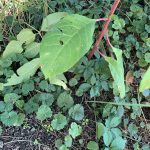
The leaves have holes from being eaten on.
The organism that I picked to observe saw an organism that was located south of my sit spot, next to the
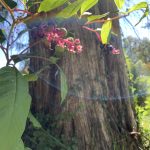
This is a picture of the berries growing at the top of the stem, as you can see they are green turning into a dark purple color.
trees with vines growing on them. After my observations I identified the plant species that I observed as the American Pokeweed, scientifically known as Phytolacca americana L. I picked this organism to observe because it had vibrant colors on the stem, and also the color of the berries intrigued me. I also have never seen this organism in my hometown, so I was interested in learning more about this plant that I have only seen a couple of times at my sit spot.
There were many observations that I observed while sitting and observing the American pokeweed. It has vibrant pink-reddish stem, that is about 2 feet long, and has big green leaves growing from the bottom all the way to the top. The leaves had a spear end and looked like an upside tear drop. Near the top of the stem there was these green berries that were turning or had already turned into this dark purple berry. The leaves were placed at random order along the stem. About halfway up the stem three of the branches stemmed out and at the tip of the stems grew more berries. It was blooming these beautiful pink flowers that will soon bloom into the berries that are on the stem.

This is what the whole plant looked like, as you can see it is about 3 feet tall.
Some of the leave had holes in them from being eaten by insects, and near the bottom of the leaves the

This is a picture of the flowers that have not yet grown berries.
leaves are starting to turn brown. The only insect I saw was a fly, who only landed on the leaves a couple of times, and after the fly there was no other interactions with other insects. The stem near the bottom seemed to be about 1 inch in diameter, and near the top of the stem it appeared to be ¼ inch in diameter. The berries look like mini pumpkins, because they have ridges on the berries. Near the top some of the leaves have black spots, that appear to be fungi. On some parts of the stem there was new leaf growth. The leaves felt very smooth like silk on the top, but on the bottom they had a very rough texture.
The plant was located to the left of the tree and was surrounded by other grasses and weeds. Those other organisms seemed to be dying because they were starting to turn brown, but some of the other organisms were still green. Because some of the other organisms surrounding the American pokeweed were dying and other organisms like the pokeweed are still vibrant and green, I assume that they are taking those nutrients away from the other organisms that are turning brown and dying. The plant is also drooping North maybe as an adaptation to get more sunlight, since they plant is shaded by the tree it is located next to.
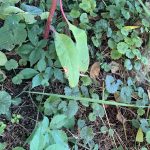
This is the bottom of the stem, with leave that are turning brown and have holes from being eaten.
The weather was very windy, and I would estimate the wind speeds to be about 5 miles per hour. The temperature was about 60 degrees Fahrenheit. Against the weather the plant seems to be pretty resistant. While observing the plant against the wind, the stem did not move that much and the only thing that was really moving was the leave and the branches near the top, that had a very flimsy stem. During this whole process of observing the organism, and identify this organism, it was very calm and relaxing. It was easier to find the plant species, compared to actually observe the plant because I had to be very descriptive in order to ensure that I could find the plant species that I was talking about. To identify the organism I searched plants with those certain characteristics that the plant displayed and after a few different searches I found that my plant was the Phytolacca Americana L. which helped me find the information I needed in order to complete my natural history summary.
Natural History
The American pokeweed, Phytolacca americana L., is a member of the Phytolaccaceae family, and they are located in every state
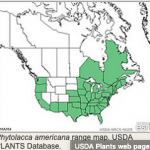
The list of all the state in America that have American pokeweed
in the United States besides Nevada, Utah, Colorado, Idaho, Wyoming, Montana, North Dakota, and South Dakota. (Taylor) There are two native species that live with in the U.S.(Taylor) When the pokeweed if full grown it is usually 6 to 10 feet tall but can reach up to 21 feet tall, and the leaves are alternate, thin, green on top, and have a lighter color on the bottom. (Taylor) The leaves tend to be 7 ¾ to 14 ¾ inches long, and 4 to 7 inches wide, and if the leaves become bruised or crushed they will produce and acrid odor. (Taylor)
The berries will start at a green color then turn into a purple/black color. They tend to live in open or edge habitats, mainly where birds can roost. (Taylor) They species will bloom year-round in Virginian and other southern states. (Conservation Plant) The berries are poisonous if they are consumed, but if curated properly they can be used for medicinal purposed, without causing any harm to the person using the product. If the berries are consumed they can cause many harmful side effects the worst side effect that can happen is death of the organism that consumed the plant. The leaves and steam can be edible and provide fats and carbohydrates if properly cooked. And each of the berries produces around 6 to 12 seeds on average.
References Cited
Taylor, D. (n.d.). U.S. Forest Service. Retrieved October 03, 2020, from http://www.fs.fed.us/wildflowers/plant-of-the-week/phytolacca_americana.shtml
Conservation Plant Characteristics for ScientificName (CommonName): USDA PLANTS. Conservation Plant Characteristics for ScientificName (CommonName) | USDA PLANTS. https://plants.usda.gov/java/charProfile?symbol=PHAM4.

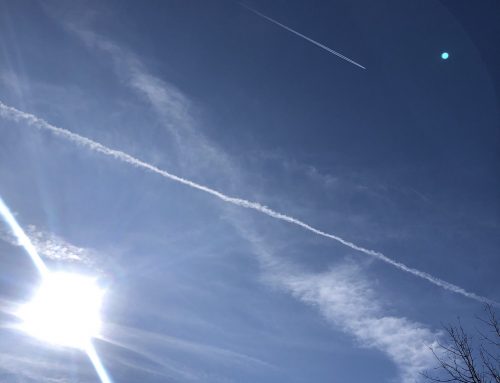
Hi, good job! You have so many details! You even used to scientific name of your organisms which is great! I love the pictures, the organism is a pretty color, and I see why you picked it.
Hi Aliya! You did a fantastic job of specifically analyzing and displaying the magnificent features of your plant. I found it fascinating to learn the many adaptations, history, and features of your plants. You described the plant you identified with beautiful imagery and descriptions that helped me imagine what the plant looked like. I loved your pictures, citations, and lively word choice that added to your style of writing and for me to comprehend your plant. I think that you did an amazing job of further analyzing key aspects of your plants, the weather conditions, location of where to find your plant, and specific textual evidence on characteristics of your plant. I loved the amount of details you provided and the different pictures you provided. Overall, I’m glad that you found the observation period of identifying feature of your plant to be peaceful. You had amazing details and I am glad to have learned more about your plant.